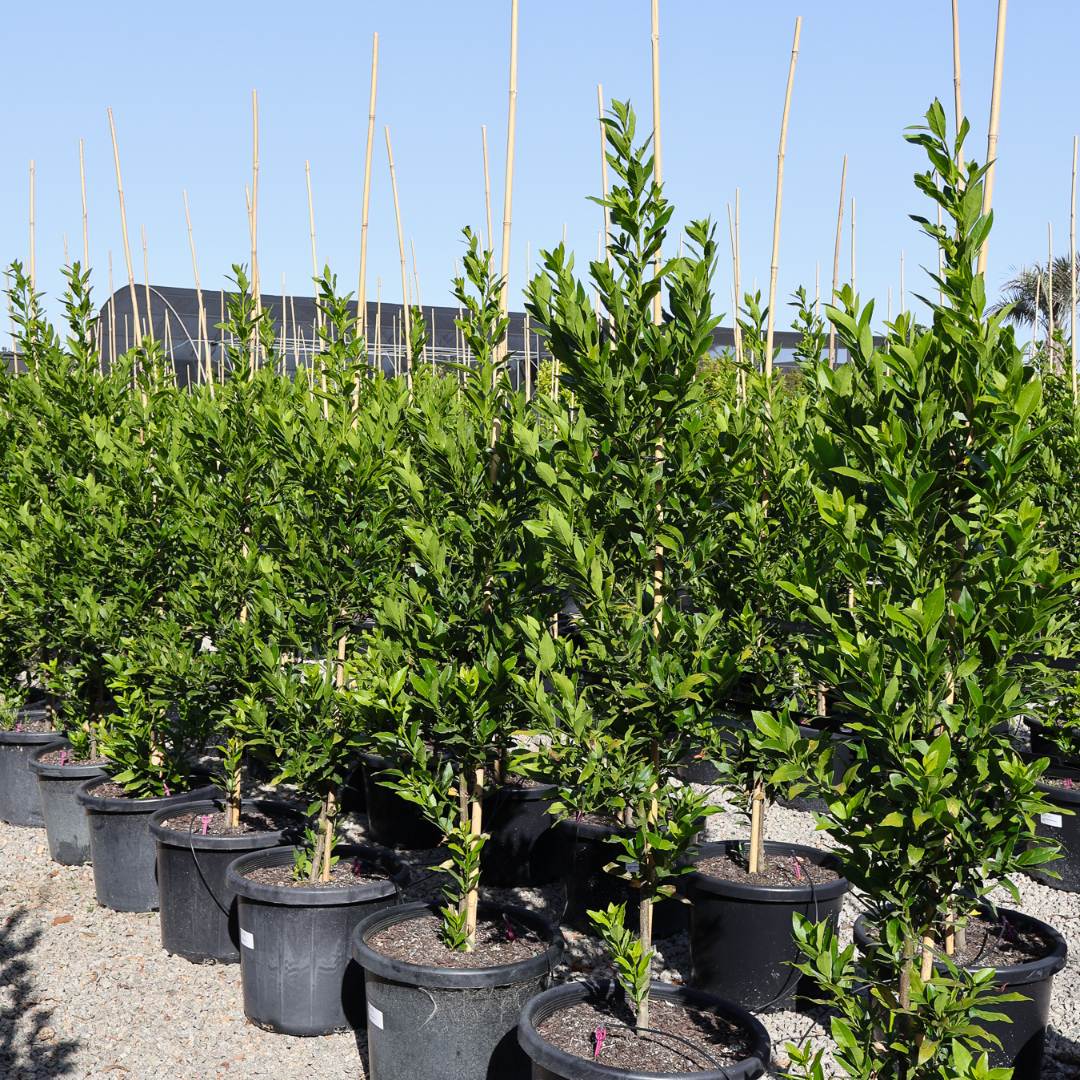The Laurus Nobilis (Bay Laurel), or bay tree, is a beautiful evergreen that adds a touch of sophistication and classic beauty to any garden. It is native to the Mediterranean region and has been used in cooking, decoration, and medicine for thousands of years.
Common Name: Bay Tree or Bay LaurelUses: Hedging Tree, Feature Tree, Topiary
Mature Height: 8m Tall approx
Mature width: 3m wide approx
Growth Rate: Slow to moderate
Foliage/ bark: Its leaves are glossy, dark green in color, and oval in shape. They hang from red-brown branches that add texture to your landscape design. The Bay Laurel also has aromatic leaves.
Flowers: In springtime clusters of small yellow flowers will appear amongst the foliage.
Evergreen/ Deciduous: Evergreen
Maintenance: Being native to the Mediterranean means that the Bay Tree does well in mild climates with plenty of sun exposure. Prune regularly if you are using it for a feature or topiary use for best results.
Soil Type: Plant it in soil that drains well - sandy soils are ideal - and provide regular watering during dry spells.
Water requirement: Drought tolerant
Origins of the Laurus Nobilis - Bay Tree
The Laurus Nobilis is one of the oldest and most reliable hedges which was used by the Romans extensively. The Bay Laurel is a small evergreen tree native to the Mediterranean region. It grows up to 8 meters tall but can be pruned into different shapes for ornamental purposes. Its leaves are glossy green with leathery texture and aromatic scent when crushed. The leaves are also used as a spice in many recipes including soups, stews, sauces, marinades, salads, and more. The Laurus Nobilis was associated with Apollo—the Greek god of healing—and was believed to possess medicinal properties.
Being southern European the bay laurel does well in dry hot summers. It will only just tolerate the humidity of Sydney, but does not cope with that of Brisbane. The Bay Laurel should thrive in Victoria, ACT and South Australia.

Uses of the Bay tree
This versatile tree can be used as a hedging plant, feature tree, or topiary piece. It is an excellent choice for topiary due to its dense foliage and natural oval shape. It can be easily shaped with regular pruning and clipping.
Bay is not suited to pleaching due to its irregular trunk shape.
Not only is the Laurus Nobilis Bay Tree visually appealing with its glossy green foliage but it also has many practical uses that can be beneficial in any garden. Its leaves are widely used in cooking due to their strong flavor; they are often used to add depth and aroma to sauces, soups, stews, marinades, and dressings. Additionally, bay leaves have medicinal properties due to their high concentration of essential oils which can help treat things like inflammation and indigestion when consumed or inhaled properly.

Where should I plant it in my garden?
The ideal location for planting a Laurus Nobilis Bay Tree is somewhere that receives plenty of sunlight but not too much heat during summer months (for example in partial shade). One of the misconceptions about bay hedges is that they require full sun. This is not true. We have seen them grown very successfully in partial and even full shade.
The Bay laurel can also thrive under established trees.

Soil conditions
Soil conditions should be well drained with plenty of organic matter to help retain moisture; avoid planting them in areas prone to waterlogging or flooding as this can cause root rot problems which may be fatal for your tree.
How far apart should I plant my Bay Trees?
As a guide, 1 plant per lineal metre will create an instant effect. Or otherwise 0.8m - 1m apart to create an instant hedge

Care & Maintenance
Laurus Nobilis Bay Trees are easy to maintain and make an ideal choice for gardens and landscaping designs with their beautiful green leaves. Prune dead branches regularly during the summer months. Its soil should be rich with nitrogen-based fertilizer throughout the growing season—especially during spring—to promote healthy growth of new foliage. Watering occasionally is recommended in dry spells. Fertilize twice a year with a balanced fertilizer mix designed for fruit trees to help ensure growth.
It is possible to keep it clipped as a medium hedge at a height of 1 metre, or let it reach a height of over 4 metres. It is not fast growing and may take four to five years before thickening into a dense hedge. But once it is established, it will reward you by requiring very little maintenance and very little water.

Bay Trees are an excellent choice for creating a beautiful outdoor space with minimal effort. With proper care, they can provide a lush and fragrant addition to any garden, bringing color and life to even the smallest of spaces. These trees require minimal maintenance but with regular pruning and watering, they will reward you with lasting beauty and years of enjoyment.








2 comments
GIMMME INFOO ABOUT THIS PLANT LIKE ITS ADAPTATIONS AAAARRRRRGGGHHHH
GIMMME INFOO ABOUT THIS PLANT LIKE ITS ADAPTATIONS AAAARRRRRGGGHHHH